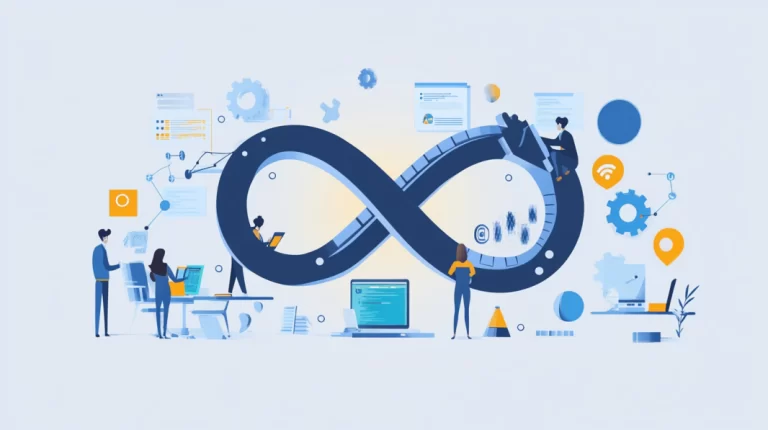
The RevOps Approach: a Strategic Asset for the Manufacturing Industry
Discover how the RevOps approach optimizes processes, aligns your teams and maximizes your performance in the manufacturing sector. A key strategy for doing more with less.

Over the past two years, it has often been claimed that artificial intelligence (AI) is overvalued in the short term and undervalued in the medium to long term. However, the situation is changing rapidly: the industry is now at a turning point where AI can truly transform processes, and concrete examples of its use are multiplying.
Where to start introducing AI into a steel company?
In this article, we’ll look at the three common stages of AI implementation in the steel industry, detail five essential steps to increasing productivity with AI, and present twelve concrete examples of its use in a steel company.

AI is revolutionizing marketing and sales practices in the steel industry. For example, by automating note-taking during meetings with tools such as Microsoft Teams, Zoom or third-party software such as Berrycast and Otter.AI, it’s possible to record every customer exchange, create meeting summaries and automatically generate follow-up tasks. These tools guarantee an up-to-date CRM while reducing manual input, all in just a few clicks.
Sales and marketing teams are often the first in companies to integrate artificial intelligence, as many of their tasks involve writing, translating, proofreading and also thinking. All these tasks can now be greatly accelerated by artificial intelligence models to improve the end result.
Concrete examples:

The second level of AI adoption in steel companies is the back-office, or administrative functions. AI can dramatically reduce the time spent on routine tasks such as entering supplier invoices and extracting key information from compliance documents.
AI has the potential to transform repetitive processes to free up valuable time, enabling teams to focus on higher value-added tasks.
Concrete examples:

It’s in the production and delivery phase that AI has the greatest potential to bring big gains for your business.
The challenge for the majority of organizations is that the key people with a good grasp of AI and technology are not often to be found within production and delivery teams, and are therefore unfamiliar with the real issues and problems faced by these teams. This greatly reduces the possibility of integrating AI quickly and effectively.
What’s more, the tools available are not yet sufficiently mature or easy to integrate. This explains why it is often the last stage of implementation in steel companies.
Order optimization and material purchasing forecasts, production planning and monitoring, quality inspection, vehicle loading planning for delivery: AI has the potential to be a powerful ally for your company’s operational performance.
Concrete examples:
Find out how one metal products manufacturer optimized production planning and boosted operational efficiency with tailor-made technology.
The 3-stage concept helps to understand how AI adoption happens incrementally in steel organizations and to identify where leverage has the most potential.
Developing a plan and methodical approach to successfully integrating AI into your business is the next step. Here’s an example of a 5-step plan you could use.
Start by analyzing your existing processes in each stage:
This assessment enables you to see where AI can make a difference.
It’s essential to appoint an AI and innovation leader within your company. This leader will ensure that AI initiatives are aligned with the company’s strategic objectives.
We also recommend collaborating with a specialized AI firm that knows your industry well, such as Code&Steel or Openmind Tech. This will enable you to benefit from industry best practices and rapidly implement AI projects.
Since AI is now ubiquitous, a clear usage policy is essential to frame the use of tools and protect your data:
Look for quick wins where AI can deliver immediate results. These early successes are crucial to demonstrating the value of AI and encouraging its adoption across the enterprise.
For maximum impact, identify the critical problems in your processes where AI could make the difference. Rather than integrating AI at all costs, start with concrete needs and problems.
Artificial intelligence is no longer a technology of tomorrow; it’s already a reality of today. Every day, at Openmind Tech and Code&Steel, we see new concrete cases of AI infusion and are surprised ourselves at the speed at which it’s all evolving.
We’re dealing with a technology that’s evolving exponentially. It’s best to prepare and move ahead as early as possible, before the competition does. The first to use the full potential of AI will most likely be tomorrow’s leaders in the steel industry.
By following a structured approach – assessing your current situation, appointing an innovation leader, defining a clear policy and identifying quick wins and gains in your critical processes – you’ll give yourself every chance of maximizing the impact of AI for your business.
Subscribe to receive our exclusive updates directly to your email.

Tell us more about your needs so that we can better route your project to our specific SWAT team.
1
During the brainstorming phase, we work with you to identify potential solutions to your business challenges to generate the technology response that aligns with your business objectives.
2
Through our requirements gathering process, we work closely with you to define and prioritize your needs, ensuring that our solutions are tailored to meet your specific requirements.
3
This phase marks the beginning of our partnership. We’ll finalize the project plan and establish clear communication channels to ensure a smooth and successful project execution.